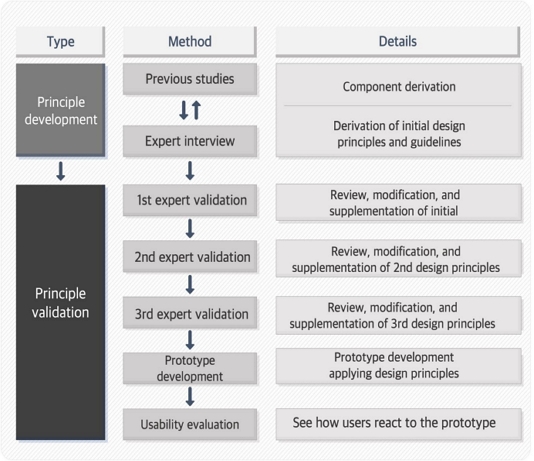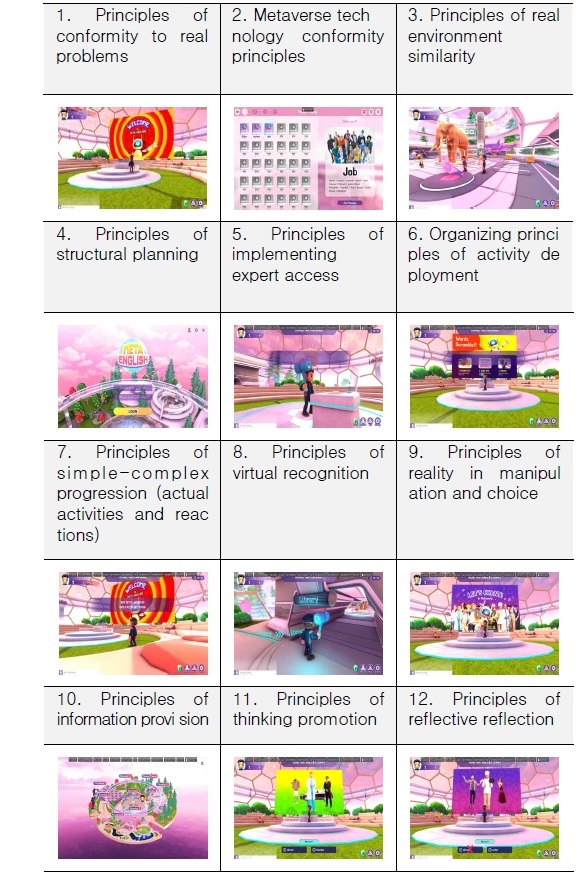
메타버스 기반 교육용 실감형 콘텐츠 저작 가이드라인 개발
Copyright ⓒ 2023 The Digital Contents Society
This is an Open Access article distributed under the terms of the Creative Commons Attribution Non-CommercialLicense(http://creativecommons.org/licenses/by-nc/3.0/) which permits unrestricted non-commercial use, distribution, and reproduction in any medium, provided the original work is properly cited.

초록
본 연구는 최근 개발이 활발한 메타버스 기반 교육용 실감형 콘텐츠를 최적의 상태로 구현하기 위한 설계원리 및 지침을 담은 저작 가이드라인의 개발과 검증에 관한 것이다. 연구 목적을 위해 설계 개발 연구 방법론에 기반하여 모형 개발과 모형 타당화의 과정을 거쳤다. 첫째, 모형 개발 단계에서는 선행연구에 기반하여 전문 개발사와 함께 연구 목적에 맞게 가이드라인을 작성하였다. 둘째, 모형 타당화 단계에서는 도출된 가이드라인을 대상으로 델파이 기법으로 전문가 의견을 수렴, 초기 저작 가이드라인이 도출되었다. 이를 적용한 프로토타입을 개발하였고, 초기 가이드라인개발에 참여하지 않은 외부 전문가 5인을 대상으로 프로토타입을 사용하게 한 후 가이드라인에 대한 외적타당화 작업을 실시하였다. 그 결과 전체 평균 4.16 (ICC(2, 1)=0.88)의 높은 적합도를 보이며 12개 설계원리 36개 문항의 최종 저작 가이드라인이 도출되었다. 본 연구는 메타버스 전문 개발사와 전문가가 참여해 메타버스 기반 교육용 실감형 콘텐츠의 최적 설계원리를 담은 저작 가이드라인을 도출하였다는데 의의가 있다.
Abstract
This study reports the development and verification of authoring guidelines containing design principles to optimally implement immersive contents for metaverse-based education, which has been actively developed recently. Model development and validation was conducted following the design development research methodology. First, in the model development stage, guidelines were drawn up on the basis of previous studies with professional developers and according to the purpose of the study. Second, for model validation, expert opinions were collected using the Delphi method, from which initial authoring guidelines were adduced. Based on this, a prototype was developed and externally validated after asking five external experts not involved in the initial guidelines to use the prototype. Final authoring guidelines of 12 design principles with 36 elements were then developed, showing a high mean fit of 4.16 (ICC(2, 1) = 0.88). This study is significant in deriving the authoring guidelines with optimized design principles of immersive contents for metaverse-based education with the participation of professional metaverse developers.
Keywords:
Metaverse, Immersive Contents, Authoring Guidelines, Virtual Reality키워드:
메타버스, 실감형 콘텐츠, 언어교육, 저작 가이드라인, 가상현실Ⅰ. 서 론
4차 산업 혁명의 집약적 생태계로 여겨지는 메타버스(Metaverse)는 세계 사회, 경제, 문화 전 영역에서 새로운 디지털 네트워크로 진보하고 있는 가운데, 메타버스를 더욱 풍성하게 만들어 줄 콘텐츠 시장 또한 주목을 받게 될 것으로 예상된다. 메타버스는 특히 e-Learning, M-Learning, Smart Learning으로 확대되던 에듀테크 시장에서 매우 빠르게 퍼져나가고 있다. 비대면 학습의 중요성이 증대됨에 따라 교육 분야에서는 AR, VR, AI, 로보틱스, 블록체인 등의 기술을 이용해 실감형 콘텐츠로 학습자의 몰입도를 높이고 있고, 학습 내용의 체화 등 교육 효과를 높이려는 다양한 시도들을 메타버스에서 행하고 있다 [1].
그런데 그래픽 등 가상현실 콘텐츠의 효과적인 개발을 가능하게 하는 기술 발전이 이루어지고 있음에도 불구하고 여전히 이를 어떻게 설계해야 하는지를 종합적이고 총체적으로 나타내는 연구가 부족한 상황이다 [2-3]. 그리고 가상현실 기반 교육용 콘텐츠에 대한 긍정적 가능성이 제기되고 있지만 어떻게 이를 설계할 것인지에 관한 접근은 초기 수준이다 [4-5]. 따라서 메타버스 기반 교육용 실감형 콘텐츠 개발과 관련해서도 새로운 테크놀로지의 특성을 고려하여 기존 미디어 산업에서 명시적ˑ묵시적으로 존재하는 콘텐츠의 창작ˑ저작과 관련된 구체적인 지침 및 설계원리를 담은 명확한 가이드라인의 개발이 필요하다. 본 연구에서는 메타버스 전문 개발사와 전문가들이 함께 참여하여 메타버스 기반 교육용 실감형 콘텐츠를 최적의 상태로 구현하기 위한 설계원리 및 지침을 담은 저작 가이드라인을 개발하고 이를 검증해 본다. 이를 위해 다음의 2가지 연구 문제를 상정하였다.
- (1) 메타버스 기반 교육용 실감형 콘텐츠의 설계원리는 무엇인가?
- (2) 도출한 메타버스 기반 교육용 실감형 콘텐츠의 설계원리를 담은 저작 가이드라인은 타당한가?
이를 통해 메타버스 기반 교육용 실감형 콘텐츠의 최적화된 설계원리를 담은 가이드라인이 개발됨으로써 콘텐츠의 체계적인 제작 과정을 지원하고, 메타버스 기술의 교육 분야 적용을 위한 시사점을 도출한다.
Ⅱ. 선행연구 고찰
2-1 메타버스 기반 교육용 콘텐츠 유형과 특징
메타버스 기술의 발전과 코로나 19로 인해 교육 현장에서의 원격수업이 활성화되었으나, 화상회의가 주는 피로감, 실재감 부족, 학습 흥미 결여, 상호작용 부족 등은 메타버스의 교육적 활용에 주목하는 계기가 되었다. 실감형 콘텐츠가 학습자의 학습 내용에 대한 몰입이나 주도적·능동적 학습 유도, 학습 내용의 체화 등 교육 효과가 높다는 것은 다수의 연구에서 입증된 바 있다 [6].
미국의 기술연구재단 ASF의 분류기준에 따라 메타버스의 러닝 콘텐츠 유형은 크게 증강현실(Augmented Reality), 라이프로깅(Life Logging), 거울세계(Mirror Worlds), 가상세계(Virtual Worlds)의 4가지 기술 유형으로 나뉜다 [7]. 메타버스의 기술적 특징과 교육적 시사점은 표 1의 내용과 같다. 본 연구에서는 메타버스 플랫폼 가운데 가장 개발이 활발하고, 연구 목적에 부합한 가상세계에 바탕을 둔 교육용 실감형 콘텐츠의 가이드라인을 개발한다.
2-2 메타버스 기반 교육용 실감형 콘텐츠 설계적 측면에 대한 연구 분석
선행연구를 통해 메타버스 기반 교육용 실감형 콘텐츠를 설계해야 할 때 고려되어야 하는 요소들을 탐색해 보았다.
박상준은 메타버스와 관련된 기존 논의들을 종합하여 메타버스가 갖는 특성을 제시한 바 있다 [8]. 제시한 메타버스의 특징을 보다 직접적으로 교육적 상황에 대입해 보면, (1)학습자는 시⋅공간의 제약이 없는 가상 세계에서 (2)보다 능동적으로 다양한 학습과 활동을 영위하며 자신의 경험을 확장시키고, (3)이러한 메타버스 내에서의 활동 및 경험이 가상 세계에 그대로 머무르거나 단절되는 것이 아니라 다시 현실에서의 학습에도 지속적으로 영향을 미친다는 특징을 제시하고 있다.
박태정은 가상현실 학습환경의 특성으로는 정보 표상의 충실성, 행위유발성, 실시간 상호작용, 시공간을 초월하는 원격 현존감과 몰입의 경험 등을 들고 있다 [9].
한형종과 임철일은 가상현실 기반 교육용 시뮬레이션 설계원리로 다양한 테크놀로지 중 가상현실 기술이 적합한지 파악하는 가상현실 기술 적합성 원리, 현실감 및 사실성 향상이 이루어지도록 현실의 환경 및 객체와 유사하게 구현하는 현실 환경 유사성 원리, 개념적 설계를 위해 사용자의 활동 전개에 따른 내용 및 화면을 구성하는 활동 전개의 구성 원리, 실제와 동일한 탐색, 조작, 선택 등의 활동이 가능한 조작 및 선택의 현실성 원리 등을 제시하고 있다 [10].
본 연구에서는 메타버스 환경과 유사한 가상현실 기반 교육용 시뮬레이션 설계원리를 근간으로 최적화된 설계가 이루어지기 위한 설계원리를 도출하고 이를 검증하였다.
Ⅲ. 연구 방법
3-1 설계·개발 연구
연구 목적을 달성하고자 본 연구는 설계·개발 연구 방법(design and development research method)을 적용하여 교수설계에서의 새로운 지식을 생성하고 이를 타당화하였다 [11]. 설계·개발 연구는 일반적으로 산출물 및 도구 연구와 모형 연구로 구분되는데, 본고에서는 모형 연구를 적용하였다. 그리고 모형 연구를 위해 모형 개발과 모형 타당화 과정을 거쳤다.
첫째, 모형 개발 단계에서는 선행연구에 기반하여 전문 개발사와 함께 메타버스 기반 교육용 실감형 콘텐츠 개발에 맞게, 그리고 연구 목적에 맞게 가이드라인을 도출하였다. 둘째, 모형 타당화 단계에서는 선행연구 기반의 가이드라인을 대상으로 메타버스 관련 전문가 5인을 대상으로 델파이 기법을 이용해 초기 저작 가이드라인을 도출하였다.
초기 저작 가이드라인에 기반하여 언어교육 관련 프로토타입을 개발하였고, 다시 초기 가이드라인개발에 참여하지 않은 외부 전문가 5인을 대상으로 프로토타입을 실행해 보게 한 후 동일한 방식으로 가이드라인에 대한 외적타당화 작업을 행하였다. 그 결과를 분석하여 최종 저작 가이드라인을 도출해냈다.
전문가 타당화 연구 방법은 전문가의 축적된 지식, 경험, 통찰로부터 연구에 많은 시사점을 얻을 수 있는데, 여기서는 그 중요성을 인식하여 경력 8년에서 24년에 이르는 메타버스 관련 프로젝트 개발자, 기업 대표 및 임원, 대학 교수자 등으로 하였다. 그리고 초기 가이드라인 작업시의 자문과 프로토타입의 개발은 VR/AR 개발과 멀티미디어 학습 콘텐츠 개발을 10년 이상 전문적으로 해 온 SC사와 함께 이루어졌다. 전문가 타당화 및 사용성 평가 참여 전문가는 표 2와 같다. 그리고 본 연구의 구체적인 연구 절차를 정리하여 제시하면 그림 1과 같다.
3-2 연구 절차
초기 설계원리를 도출하기 위해 먼저 선행연구를 수행하였다. 그리고 경험적 측면에서 현장의 맥락과 구체성을 반영하고자 메타버스 관련 전문기업 참여와 전문가 설문조사를 병행하였다.
한형종과 임철일의 ‘가상현실 기반 교육용 시뮬레이션 설계원리’ [10]를 근간으로 해서 AR, VR 기반 교육용 콘텐츠를 10년 이상 전문적으로 해 온 개발사와의 심도 깊은 논의와 종합적인 접근을 통해 메타버스 기반 실감형 교육용 콘텐츠의 개발에 맞게, 그리고 연구 목적에 맞게 문항을 수정하였다.
이를 기반으로 전문가 1차 타당화 작업이 이루어졌다. 내적 타당화를 위한 전문가 선정은 연구결과의 질적 향상에 영향을 미칠 수 있는 중요한 측면으로 해당 영역에서의 전문성은 연구 실적, 현장에서의 경험 등을 통해 판단 가능하다 [12-14]. 델파이 기법(Delphi method)에 근간하여, 대상은 실제 기업에서 가상현실 기반의 교육용 콘텐츠를 설계하거나 개발한 경험을 지닌 15년 이상 경력의 콘텐츠 설계자 3인과 가상현실 및 메타버스 기반 콘텐츠 개발 관련 학과 교수자 2인의 총 5인을 대상으로 3회에 걸쳐 이루어졌다. 전문가 5인의 이력은 앞에서 제시한 표 2와 같다. 각 문항은 5점 리커트 척도로 구성되었고, 전문가의 의견을 자유롭게 기술할 수 있도록 개방형 문항을 추가하였다. 타당화 작업은 2022년 6월 1일부터~6월 30일까지 1달에 걸쳐 실시되었다.
외적타당화의 주요 목적은 개발된 산출물이 현장이나 학습에 어떠한 영향을 미치는지를 확인하는 것이다 [15].
이를 위해 본 연구에서는 도출된 설계원리가 적용된 초기 가이드라인을 적용하여 프로토타입을 개발한 후 외부 전문가를 대상으로 사용자 테스트를 실시하였다. 프로토타입 콘텐츠의 내용은 어학교육 서비스 플랫폼 구축과 관련된 선행연구를 바탕으로 초등 영어 Vocabulary 학습으로 하였다 [16-17]. 그 이유는 영어 콘텐츠의 특성상 온라인 의존도가 높고, 플래시카드의 높은 학습 효과에도 불구하고 종이나 제작 과정 등 물리적인 비용이 너무 커 수업 시간에 필요한 단어카드를 만들지 못했던 기존 플래시카드의 문제점을 메타버스라는 새로운 기술을 통해 해결하고자 하였다.
프로토타입의 개발이 완료된 후 메타버스 기반 교육용 실감형 콘텐츠의 설계원리가 적용된 저작 가이드라인에 대한 외적타당화 작업을 위해 초기 가이드라인 개발에 참여하지 않은 외부 전문가 5인을 사용자로 규정하여 가이드라인 문항에 대해 평가하게 하였다. 이와 함께 반구조화된 질문을 활용하여 구체적인 수정 및 보완 의견 등도 확인하였다. 콘텐츠의 실제 사용자인 초등학생을 사용자 테스트에 적용하지 않은 이유는 프로토타입이 전체적인 교육 커리큘럼에서의 학습 flow를 모두 보여 줄 수 없는 한계가 있어, 외적타당화 작업에 프로토타입의 한계를 고려할 수 있는 대상자가 적합하였고 [18], 전문적인 저작 가이드라인 확립이 연구의 목적이기 때문이다.
Ⅳ. 연구 결과
4-1 메타버스 기반 교육용 실감형 콘텐츠 초기 가이드라인 도출
메타버스 기반 교육용 실감형 콘텐츠의 설계원리는 관련 선행연구 고찰과 전문 개발사와의 논의를 통해 만들어졌다. 선행연구를 통해 도출된 가이드라인은 표 3과 같다. 이를 기반으로 전문가 5인을 대상으로 델파이 기법을 이용하여 설계원리에 대한 내적 타당화 작업이 이루어졌다. 총 3차에 걸쳐서 설문과 문항수정, 그리고 개방형 기술을 통한 의견 수렴 등의 과정이 반복되었다.
선행연구에 기반한 가이드라인에 대한 1차 설문 조사가 이루어졌고 전문가들 사이의 적합도 평가 결과 평가자간 일치도가 낮아 v10a3 (p<.05) 항목이 유의하게 차이가 나타나 수정이 필요하고, v5a2 v7a3, v2a1, v2a2, v9a3, v10a3 문항에 대해서는 일치도 제고를 위해 문항을 재검토할 필요성이 대두되었다. 이는 전문가들의 의견이 다양하다는 것을 의미한다. 전문 개발사와 함께 논의 과정을 거쳐 해당 문항을 수정 및 보완하고 다시 2차 설문 작업을 수행하였다. 수정된 내용은 시뮬레이션의 특성이 담긴 내용에 대해 일반 교육용 콘텐츠의 실제적인 설계 및 개발의 특성에 맞게 용어가 수정되었고, 적합하지 않은 지침의 삭제, 그리고 명시적으로 표현해야 할 용어 등이 추가되었다. 그 결과 다시 v5a2, v7a1, v7a2, v7a3, v8a1, v8a2 문항에 대해 일치도 제고를 위해 문항을 재검토할 필요성이 대두되었다. 단순-복잡의 진행원리와 가상인식의 원리에 대한 전문가들의 인식 차이가 나타났다. 이들 문항을 수정하여 3차 설문 작업에 들어갔고 그 결과 가이드라인 전반과 각 권고 사항들의 값이 0.4 이상이고, 급내상관계수(ICC; intraclass Correlation Coefficient) 분석 결과도 평균측도 ICC(2,1)=0.983 (95 CI=0.95 ~ 0.998), p<0.001인 매우 높은 수준의 일치도(Excellent)를 보이는 초기 가이드라인을 개발하였다. 가이드라인에 대한 전문가들의 의견 일치도 향상 과정은 표 4와 같다.
4-2 프로토타입 개발
이상의 수정된 설계원리를 기반으로 프로토타입의 개발이 이루어졌다. 프로토타입 개발은 초기 가이드라인 작업에 참여한 전문 개발사에서 7월부터 10월까지 총 4개월에 걸쳐 개발이 이루어졌다. 어휘 학습을 위해 개발된 프로토타입의 주요 가이드라인이 반영된 화면은 그림 2와 같다.
4-3 외적타당화 작업을 위한 사용자 평가
초기 가이드라인에 대한 외적타당화 작업을 위해 완성된 프로토타입을 가이드라인 연구에 참여하지 않았던 전문가 5인을 대상으로 초기 저작가이드라인 문항들에 대한 설문조사를 수행하였다.
반구조화된 질문을 활용하여 전문가의 구체적인 수정 및 보완 의견 등도 서술하게 하였다.
그 결과 외부 전문가 5인이 전체 평균 4.16 (ICC(2, 1)=0.88)의 높은 적합도를 보이며 12개 설계원리 36개 문항의 저작 가이드라인이 만들어졌다. 그러나 표 5의 문항별 사용성 평가 기술통계 결과 Q5S1(문제에 대해 전문가가 나타내는 적절한 접근 방식과 초보자가 오류를 범할 수 있는 적절하지 않는 방식이 무엇인지를 확인하여 예상되는 행동을 도출), Q12S2(학습 활동을 적절하게 수행하지 않았을 경우 다시 활동이 이루어질 수 있도록 기회를 제공) 항목은 비교적 낮은 점수로 나와 세부항목에 대한 검토가 필요하였다.
이에 따라 교육용 콘텐츠에 더 적합하게 용어를 수정하고, 학습 활동을 적절하게 수행하지 않았을 경우 다음 단계로 바로 넘어갈 수 있는 자유도를 주는 방향으로 내용을 수정하였다. 그리고 반구조화된 질문을 활용하여 전문가의 구체적인 수정 및 보완 의견 등을 정리한 결과는 표 6과 같다.

Analysis of Advantages and Disadvantages and Improvements Based on Open Technology by External Experts
대체적으로 프로토타입의 장점으로는 메타버스가 갖는 실감형 학습에 대한 학습 효과와 동기 유발, 그리고 메타버스라는 새로운 플랫폼에서의 플래시 카드를 활용한 새로운 학습법의 참신함 등이 거론되었다. 단점으로는 메타버스에서의 초기 접근의 어려움, 자유도, 상호작용성, 콘텐츠 내용이나 조작과 관련된 구체적인 가이드 제시, 기존 웹 기반의 이러닝 학습과 다른 환경에 따른 교수자나 학습자의 교육적 목적에서의 미비함 등이 지적되었다.
Ⅴ. 논의 및 결론
본 연구의 목적은 메타버스 기반 교육용 실감형 콘텐츠를 최적의 상태로 구현하기 위한 설계원리 및 지침을 담은 저작 가이드라인의 개발과 검증에 관한 것이다. 연구를 위해 설계 개발 연구 방법론에 기반하여 모형 개발과 모형 타당화의 과정을 거쳤다.
연구문제 (1) 메타버스 기반 교육용 실감형 콘텐츠의 설계원리는 무엇인가?의 모형 개발을 위해 선행연구를 분석한 후 AR, VR 기반 교육용 콘텐츠를 10년 이상 전문적으로 해 온 개발사와 심도 깊은 논의와 종합적인 접근을 통해 메타버스 기반 실감형 교육용 콘텐츠의 개발과 내용에 맞는 설계원리 및 지침이 적용된 가이드라인을 작성하였다.
연구문제 (2) 도출한 메타버스 기반 교육용 실감형 콘텐츠의 설계원리를 담은 저작 가이드라인은 타당한가?라는 모형 타당화를 위해 연구문제 1에서 도출된 설계원리 및 지침을 기반으로 전문가 5인의 3회에 걸친 델파이 조사에 근간하여 초기 저작 가이드라인을 도출해 냈다.
이상의 과정을 통해 도출된 초기 저작 가이드라인을 기반으로 초등 영어 Vocabulary 학습과 관련된 프로토타입의 개발이 전문 개발사에 의해 이루어졌다. 모형 타당화 작업은 초기 가이드라인 작업에 참여하지 않았던 외부 전문가 5인을 대상으로 사용자평가를 통한 외부타당화 작업을 행하였다.
그 결과 설문 결과와 개방형 서술 등을 종합하고 분석하여, 메타버스 기반 교육용 실감형 콘텐츠의 최적화된 설계를 위한 총 12개 설계원리 36개 문항의 저작 가이드라인을 도출해내게 되었다. 지금까지의 연구 과정으로부터 도출된 시사점은 다음과 같다.
첫째, 교육용 콘텐츠의 경우 연령이 낮은 학습자가 활용하는 경우가 많아 원활한 학습 목표를 달성하기 위해서는 이용 전 콘텐츠 내용이나 조작과 관련된 구체적이고도 친절한 가이드가 가장 필요한 것으로 나타났다. 그리고 ‘피드백’, ‘상호작용’, ‘높은 자유도’의 중요성이 대두되었다. 추후 메타버스에서 실감형 콘텐츠를 개발하고자 할 때에는 무엇보다도 이 부분을 중점적으로 염두에 두고 개발이 이루어져야 할 필요가 있다. 둘째, 메타버스 기반 교육용 실감형 콘텐츠 저작 가이드라인에서 교육용 콘텐츠의 특성에 부합한 권고 사항을 구체적으로 기술할 필요가 있음이 지적되었다. 여기에서 개발하고자 하는 가이드라인은 교육용 콘텐츠 개발에 대한 지침을 제공하는 데 목적이 있기 때문에 교육 대상자의 연령, 교육목적, 교육 콘텐츠의 유형을 고려한 권고 사항을 제시할 필요가 있다.
본 연구를 통해 메타버스에서도 기존 미디어 산업과 같이 명시적·묵시적 콘텐츠 창작 가이드라인을 제시, 메타버스 기반 실감형 콘텐츠의 체계적인 제작 과정을 지원하고 콘텐츠의 품질 향상에도 기여할 수 있을 것이다.
연구의 한계점으로는 초기 가이드라인에 대한 외적타당화 작업을 위해 프로토타입의 한계를 고려할 수 있는 대상자로 초기 가이드라인 작업에 참여하지 않은 외부 전문가를 대상으로 연구가 이루어졌는데, 추후에는 실제 사용자인 초등학생을 대상으로 사용자 평가가 확대되어야 할 필요가 있다.
둘째, 개발한 프로토타입에 대한 사용자 반응을 수집함에 있어 사용자의 체험이 온전히 이루어지지 못한 한계를 지닌다. 프로토타입이어서 체계적이고 절차적인 학습이 어려워, 교육적·학습적 측면보다 게임 학습적 측면이 강조된 경향을 보였다. 이 부분을 보완할 후속 연구가 필요하다.
본 연구는 메타버스 기반 교육용 콘텐츠의 효과적인 개발을 가능하게 하는 기술 발전이 이루어지고 있고 긍정적인 교육 효과에도 불구하고 어떻게 설계해야 하는지를 종합적이고 총체적으로 나타내는 연구가 초기 단계에 머무르고 있는 상황에서, 메타버스 전문 개발사와 전문가들이 참여하여 메타버스 기반 교육용 실감형 콘텐츠를 최적의 상태로 구현하기 위한 설계원리 및 지침을 담은 저작 가이드라인을 도출해 내었다는 데 그 연구 의의가 있다.
Acknowledgments
이 논문은 2022년도 정부(과학기술정보통신부)의 재원으로 정보통신기획평가원의 지원에 의하여 이루어진 연구로서, 관계부처에 감사드립니다. (2022-0-00022, 초실감 메타버스 서비스를 위한 실사기반 입체영상 공간컴퓨팅 기술 개발)
References
- Research Report on Culture and Arts Education Using the Going with metaverse, Gyeonggi Culture Foundation, Gyeonggi Culture and Arts Education Support Center, 2021.
- R. indgren, J. M. Moshell and C. E. Hughes, Virtual Environments as a Tool for Conceptual Learning, In Handbook of Virtual Environments: Design, Implementation, and Applications, Second Edition, CRC Press, pp. 1043-1055, 2014.
- D. Liu, C. Dede, R. Huang and J. Richards, (Eds), Virtual, augmented, and mixed realities in education, Singapore: Springer, 2017.
- J. M. Spector, M. D. Merrill, J. Elen, and M. J. Bishop, Handbook of research on educational communications and technology New York Springer, pp. 723-734, 2013.
- K. S. Hale and K. M. Stanney, Handbook of virtual environments: Design, implementation, and applications, CRC Press, 2014.
- B. K. Kye, N. R. Han, E. J. Kim, Y. J. Park and S. Y. Cho, Educational Use of the Metaverse: Possibility and Limitations, KERIS, RM2021-6, pp. 1-36, Jun 2021.
- S. Jone, Metaverse Roadmap, Acceleration Studies Foundation, 2006.
- S. J. Park, Future Education after COVID-19: Student initiative, metaverse education, blended learning, history of educational science, 2021
- T. J. Park, “Developing and Applying Design Principles for Maker Programs Using Virtual Reality : Focusing on the Development of Simulation Application”, Journal of Information Technology Service, Vol. 19, No. 6, pp. 161-175, Dec 2020.
- H. J. Han and C. L. Lim, “A Developmental Study on Design Principles for Virtual Reality Based Educational Simulation”, Journal of Educational Technology, Vol. 36, No. 2, pp. 221-264, Jun 2020.
- R. C.Richey, and J. D.Klein, “Design and development research: Methods, strategies, and issues”. Routledge, 2008
- D. L. Streiner, and G. R. Norman, Health Measurement Scales: A practical guide to their development and use 4th Edition, NY: Oxford University Press, 2008
-
L. L. Davis, “Instrument review: Getting the most from a panel of experts”, Applied Research, Vol. 5, No. 4, pp. 194-197, Jan 2007.
[https://doi.org/10.1016/S0897-1897(05)80008-4]

-
K. A. Ericsson and N. Charness, “Expert performance: Its structure and acquisition”, American Psychologist, Vol. 49, No. 8, pp. 725-747, Aug 1994.
[https://doi.org/10.1037/0003-066X.49.8.725]

- R. C. Richey, and J. D. Klein, Design and development research: Methods, strategies, and issues, Routledge, 2007
-
G. S. Yoo and K. Chun, "A Study on The Development of A Game-type Language Education Service Platform Based on Metaverse", Journal of Digital Contents Society, vol. 22, no. 9, pp. 1377-1386. Sep 2021.
[https://doi.org/10.9728/dcs.2021.22.9.1377]

-
H. C. Na, Y. J. Lee, S. Y. Kim, and Y. S. Kim, “A Study on Metaverse Education Platform: cases analysis and suggestion”, vol. 23, no. 5, pp. 827-836, May 2022.
[https://doi.org/10.9728/dcs.2021.22.9.1377]

-
D. Jan, D. R. Dries, V. Mathijs, G. David, S. B. Jan and L. Kris, “Comparing User Interaction with Low and High Fidelity Prototypes of Tabletop Surfaces”, NordiCHI '10 : 6th Nordic Conference on Human-Computer Interaction, Reykjavik Iceland, pp. 148-257, Oct 2010.
[https://doi.org/10.1145/1868914.1868935]

저자소개

1987년 : 고려대학교(문학사)
2004년 : 서강대학교 언론대학원(언론학석사)
2012년 : KAIST 문화기술대학원(공학박사)
1987~2021년: 금성출판사 R&D 이사
2022년: 성결대학교 홍보미디어센터 연구원
※관심분야 : 메타버스(Metaverse), 에듀테크(EduTech), 실감형 콘텐츠(VR Contents) 등

